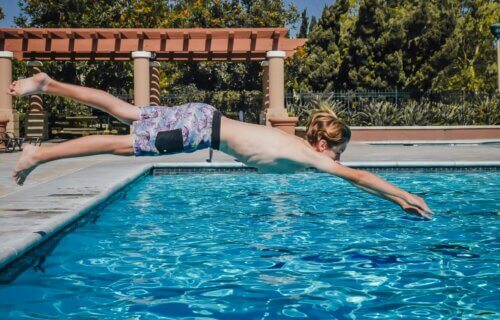ITHACA, N.Y. — Depending on the form and technique, diving into a swimming pool can either be poetry in motion or the aquatic equivalent of a car wreck. Now, scientists at Cornell University have used biomechanics to come up with a formula for safe diving.
After measuring the impact of head-first, hand-first, and feet-first diving, study authors put together a model for measuring the impact of different shapes as they plunge into a body of water.
For a novice, untrained diver, researchers say spinal cord and neck injuries are more likely to occur during a head-first dive of more than 26 feet. Meanwhile, collarbone injuries are more likely during a hand-first dive of roughly 40 feet, and knee injuries are likely when diving feet-first from over 49 away from the water.
“Water is 1,000 times denser than air, so you are moving from a very dilute medium to a very dense medium, and you’re going to experience a huge impact,” says senior study author Sunghwan Jung, professor of biological and environmental engineering in the College of Agriculture and Life Sciences, in a media release.
“Humans can choose how they dive, so we wanted to look at the effect of the position of diving. We also wanted to come up with a more universal or general theory of how objects or different shape fronts dive into water, so we looked at the diving fronts of both humans in different postures and animals and measured the forces of impact of the different shapes.”
Which diving animals are scientists learning from?
Study authors used a series of 3D-printed models depicting a near-life-sized human head and torso, torso and head with arms outstretched, and feet while diving. They also used models of a harbor porpoise head, a Northern gannet beak, and a basilisk lizard foot, to conduct this research. All of those various models allowed the research team to analyze the impact of curved, pointy, and flat shapes, respectively, on a body of water’s surface.
While throwing each model into water, scientists measured the forces acting on them and how they distributed over time. This approach facilitated the development of a theoretical model capable of describing the increase in force on the various shapes, and how those forces increased with the height of the dive.
Next, researchers plotted the maximum height and force impact human muscles, ligaments, and bones can withstand during a dive — calculating the probability of various injuries (collarbone, spine, and knee) at different heights and in different diving positions.
“In human biomechanics, there is a huge literature on the falling injury, especially in the elderly, and the sports injury, like concussions, but I don’t know of any other work on diving injuries,” Prof. Jung explains.
Taking a big jump? Go feet-first
Study authors hope their work helps people make safer diving choices. For example, a feet-first dive is safer from a higher perch.
Additionally, this project also highlights how well-adapted certain plunge-diving animals are to withstanding and minimizing the impact of a dive. For instance, northern gannets have shallower beak angles. This unique feature helps them dive into water at up to 79 feet per second. Meanwhile, dolphins have shortened, fused cervical vertebrae, which support their head as they porpoise.
“As engineers, we are very good at making the airplane fly in the air. We are good at making a submarine move in the water, but crossing the interface, as you see in the animal world, is no easy task, and is something engineers are interested in – having a drone go from water to air or air to water, for example,” Prof. Jung concludes. “So maybe this study can shed light on the new engineering design in the future that would allow systems to do this. For us, we try to understand the fundamental mechanics.”
The study is published in the journal Science Advances.


…or you can just start diving with a gradual increase in difficulty and learn by doing.
I would wager these egg-heads studying this are some of the most unathletic guys on planet earth.